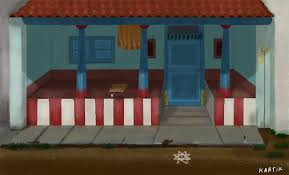 |
| Agraharam. Tamil Nadu. commons.wikimedia.org |
The Agraharam is a cultural heritage space in Kerala, but else where it is not. The Agraharams, once a center of cultural activities a few decades ago, came up on a land granted to Brahmins by the local ruler or king for the simple reason: to look after the temples and to reside there with their families. This is the reason why many Agraharams existed in close proximity to the temples - be they Shiva, Vishnu or Shakti temples. Rulers from the Chola, Pallava Nayak and Maratha dynasties did build Agraharams and grant lands to the priests for livelihood and sustenance. Practice of religion and maintenance of temples were the main reasons for setting up Agraharams close to the places of Hindu worship.
 |
| A small house in an Agraharam. reddit.com |
India being a land of tens of thousands of temples, day to day life is evolved around the temples. Daily (Nithya) puja protocols/ rituals, numerous temple festivals had to be done acceding to certain Agama rules or norms, etc., required the presence of temple priests close to the Agrahara space. The Palani Murugan temple, Palani (Pazhni), Madurai Meenakshi temple and Andal temple of Srivilliputhur are good examples. The traders and others near by depend on visitors to these temples there.
The general plan of an Agraharam is simple - rows of almost similar looking self- contained houses with a common wall. They were built on either side of the street with a well or more than one to get potable water depending on the places. At the end of the street there will be a Vishnu temple and on the other end there will be a Shiva temple. The masonry structure will have just only one floor - ground floor and tiled (mostly curved country tiles with a few stacked layers; locally known as naatoddu) roof. Some may have a two-story structure consisting of a small part with Madras terraced roof and the rest with tiled roof. Open yard (miththam in Tamil) inside the house, wide front thinnai (raised platform/ pial with a slanting tiled roof are common features. The number and the size of open yards inside the house may vary, depending on the financial status of the families, but it will be commonly three - for reception, living space and kitchen. Open yard provides good aeration and light and is also used for conducting household ceremonies. It may be partly covered atop. Many houses may have a separate self- contained room meant for the menstruating women. Entry into the house is through a narrow passage - roughly 8 feet by 6 feet (locally called razhi). In the 1950s toilets were set a bit away from the living quarters. Some houses did have a separate shed to keep the cows and also bulls to be used for pulling the cart.
The question mostly asked by a Brahmin diaspora is: Why have the Agraharam houses in Tamil Nadu disappeared fast in the last three decades? (please refer to the post at: https://navrangindia.blogspot.com/2016/01/agraharam-brahmin-community-living.html
Indeed, it is a moot question and there are many reasons. Beginning in the 1960s young brahmin boys started venturing out of their native places upon graduation to seek jobs in Chennai or elsewhere. Since the Brahmin communities of the Delta districts and other places had difficulty in getting adequate income from their small land spread parents did not mind sending their educated boys to take up jobs in far-off places to supplement the family income. Farm labor had begun to squeeze the land lords, both small and big. As a section of ambitious young men armed with good academic records started going abroad to the US, Canada, Europe, etc., on scholarship, many households became deserted with no young men to take care the land and the house. With dwindling younger generation, senior people in the Agraharam began selling their agricultural lands and also the house. The local temples can not give employment to a member of each family in the Agraharam. On top of it, priests (Archagas) taking care of the temple do not get enough income to run their families. They received a paltry amount as salary and were dependent on the ''Thattu Panam'' ( money placed on the Aati plate. Taking care of daily puja rituals and keeping an eye on the expensive temple jewelry is a tough job. In the last one decade or more, theft of temple jewelry and expensive antique metal idols of god is on the increase giving heart burns to the temple priests and the management.
Consequently in the gradually shrinking space in the left over Agrahara one can see Brahmin families that can be counted on our finger. Of course there are a few exceptions. Labor and material costs being prohibitive, many owners have difficulty in repairing the crumbling structure. If the house is near an urban or a semi urban area it may fetch enough money to buy a house elsewhere. On the other hand, if the Agraharam is in a remote place it is worthless to repair the house.
When the young people move out leaving behind their aging parents, they would prefer a place closer to their son or somebody to take care of their needs particularly, health care. In the case of parents with insufficient income, situation will be pathetic.
Yet another underlying reason for the disappearance of remaining Agraharam houses in Thanjavur district and elsewhere is due to political and social reasons. Consequently, countless temples in the interior places of Tamil Nadu are either in a dilapidated state or no responsible persons are there to take care of them. In course of time in the future, they will become vestiges of once flourishing places of worship.
https://www.thehindu.com/real-estate/the-unique-charm-of-agraharams/article19295434.ece









.jfif)